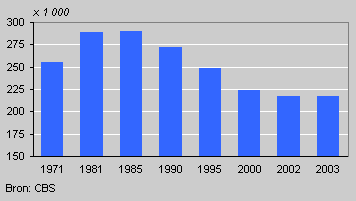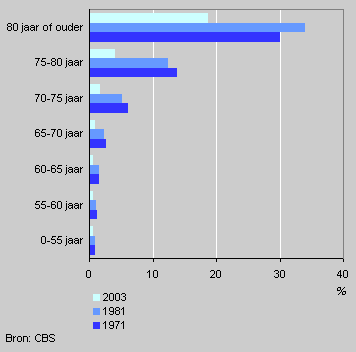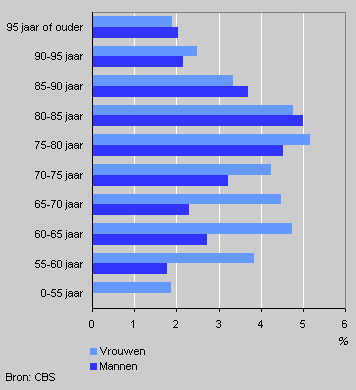Institutionalised population no longer decreasing

In the Netherlands, 217 thousand people lived in a home or institution setting on 1 January 2003, slightly more than on 1 January 2002. The decrease in the number of residents of homes and institutions, which started in the mid-eighties, has thus apparently now come to an end.
Residents in homes and institutions, 1971-2003

Home nursing and care
In spite of the ageing of the population, the number of residents in homes for the elderly and nursing homes has been falling since the mid-eighties. This was partly the effect of government policy measures. In 1977 the government declared that all available places in homes for the elderly and nursing homes were only intended for people who could no longer look after themselves.
Organisations were set up for people who needed assistance to live independently, providing nursing and other care for the elderly in their own homes.
Percentage of people living in homes and institutions, 1971, 1981 and 2003

Fewer elderly move to a home
The effect of this government policy was small in the first years. After 1981, however, the percentage of the population living in homes and institutions fell sharply.
The share of people aged 65 and older in particular in such homes dropped. In 1981 nearly 10 percent of over-65s in the Netherlands lived in a home, by 2003 this had dropped to 6 percent. The decrease was sharpest in relative terms among the population aged between 70 and 80 years.
Average annual decrease in percentage of people living in homes and institutions, 1995-2003

Largest decrease for women
The share of women in homes and institutions fell more sharply than the share of men living in these homes.
Between 1995 and 2003 the share of 55-85 year-old women in these homes fell by nearly 5 percent a year. The share of men fell by less than 4 percent.
The development in life expectancy probably played a part in this respect. Male life expectancy is increasing, while for it is stable. More men are surviving their wives, thus increasing the demand for permanent nursing and other care.
Carel Harmsen en Helma Schapendonk-Maas